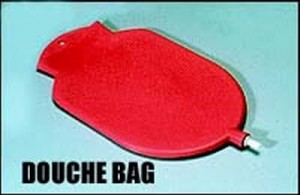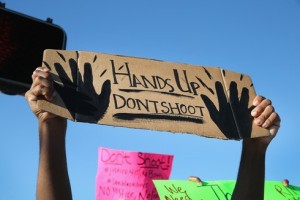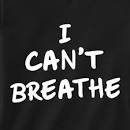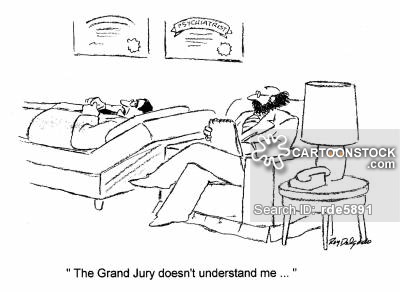
Each month we at Boom Bap Radio will bestow "The Douchey McDouche Bag" award on the biggest dickheads in the news. This category is not limited to politicians or entertainers or even athletes, there's room for everyone on this bench.
However, each month one person stands out as the absolute winner of our coveted prize.
The award is based on the name I gave a menial worker from a big box department store, who insisted that my item was no longer in stock without looking. This douche actually made me order the item online and had a whole five-minute explanation of why the product was not available days after Christmas. Evidently it was shipped back to some remote warehouse over the hills and far, far away.
Imagine my surprise when about an hour later, while walking to the other end of the store, I found piles of my item, neatly stacked and very much available.
So, this one goes out to that collared shirt wonder, who obviously knew nothing, but before he knew a whole friggin' lot “Douche Bag!!" Hey dickwad - this award  goes out to you - Douche!!!
The November 2014 Douchey McDouche Bag Award
Unless you have been living under a rock or somehow have been stuck in the back of squad car for the last few weeks, you couldn’t miss what would be the target of our latest walk of shame, a little something we call: the Douchey McDouche Bag Award.
Not too surprisingly, the November 2014 award goes to the busted justice system that not only allows police officers to act as judge, jury and executioner, but also allows its judicial branch to decide whether to hand down secret indictments against their co-workers.
I guess the blindfold is still firmly affixed to the eyes of lady justice.
We are of course talking about the indictments that never came after former Ferguson, Mo. Policeman Darren Wilson shot and killed unarmed Michael Brown and after NYC Policeman Daniel Pantaleo took a ride on the back and neck of unarmed Eric Garner before choking him to death for allegedly selling “loosies” on the corner.
So, in November 2014, when most give thanks or at least a little pie to their neighbors, police were giving unarmed black men a heaping helping of death and still getting away with it.
In fact, as both the Brown shooting and Garner choking seemed to show, the practice of police being protected by the blue wall of silence obviously appears to extend out of squad rooms and into the judicial process with its prosecutors and grand juries.
While the two most high profile cases were to launch numerous protests, November was also the month that brought us fresh fodder for the movement in the deaths of unarmed 12-year-old Tamir Rice in Cleveland and Akai Gurley in Brooklyn, NY.
For anyone who has had the experience of growing up as a Black male in the United States, these incidents of death are neither surprising nor unexpected. It has always been part of the fare for living in the land of the free and defines to whom the traditional American song refers when mentioning “the home of the brave.â€
As a card carrying member of this vaunted club, most of us know that any routine traffic stop can go horrifically wrong when you have a scared police officer asking the questions, usually at gunpoint, and that officer happens to believe every stereotype he or she has been fed about a group of people whom they have been taught to fear.
It is for these reasons that, while we were not surprised Michael Brown, Eric Garner, Tamir Rice and Akai Gurley were cut down like nameless pests, their deaths proved the whole system needs an obvious douche with our patented Douche Master 2000 – and we’re just the folks to administer the cleansing.
I Can’t Breathe
In the Black community video images have become indelible reminders of the need to struggle on and triumph over the oppressors of justice for all.
In the 60’s, for me, it was the horrific images of Civil Rights marchers having to fight not only for freedom and the right to vote, but also against German Shepherds, fire hoses and marauding bands of police officers with night sticks.
In the 80’s it was the beating and kicking of motorist Rodney King at the hands of police that created an indelible image of police violence.
But in July of 2014 it was the “Radio Raheem-esc†choking of former NY Parks Department botanist Eric Garner, who while talking to one officer for seconds, was surprised by a second officer. The second officer, Daniel Pantaleo, jumped on Garner’s back and hung onto his neck, while applying an apparent and illegal chokehold until he was no longer able to breathe.
All of these images, with the first two being provided by way of television, have become part of our story and part of our struggle for equality in the Black community and almost like the “where were you moments†of man on the Moon, shooting of JFK and MLK, they have resonated without a time stamp and have become the things we just cannot forget.
Each time the images seemed to be cries for help and obvious proof that a whole community was not whining or crying wolf about police brutality.
However, despite their clarity, these images usually mean nothing against a faulty legal system that seems to consistently re-inforce and define two separate sets of rules and two separate America’s for minorities.
In July, the cell phone video image taken by a by-stander, captured the final moments of Eric Garner’s life and seemed to again suggest that irrefutable proof would be enough to guide blind justice to the path of righteousness. However, for what has been mostly the case in America, the facts had no bearing on the actions of police.
Garner, who was a mountain of a man and former city Parks Department employee, was actually blamed for his own death after it was learned he had asthma. Evidently, if he were in better physical shape and didn’t have a breathing condition, he would have survived a wrestling takedown by a police officer, who could have more easily arrested or fined him.
In fact, once cleared of charges, Pantaleo continued the disturbing trend of the day and almost boasted through his attorney, that despite a homicide charge and what millions of people around the world saw as clear cut abuse, he did nothing wrong.
Pantaleo said the chokehold he imployed was nothing more than a figment of our collective imagination. He said through his attorney Stuart London, Esq.; that he actually never exerted any pressure while choking Garner.
The same arrogance was seen moments after George Zimmerman was cleared in Florida and on all of the money earning interviews Ferguson Officer Darren Wilson participated in after he was not indicted for shooting an unarmed man a total of six times.
The display of arrogance from triumphant attorneys of these shooters seems to demonstrate that police are above the law and that those not coveted by the system have few rights. These displays are usually met with a public reaction of blind fury by the way of protests, riots and looting.
In Ferguson, weeks of protest after the shooting were followed by more protests and riots after a secret grand jury chose to not indict Wilson.
In New York, less mayhem led to what is expected to be the beginning of the movement to change laws surrounding police violence, the people allowed to serve as officers and the situations in which a grand jury is used to bring a criminal indictment.
In both cases, the public questioned why the officers in question were not at least allowed a day in court to fully explain the circumstances by which they felt compelled to shoot or choke un-armed suspects to death instead of arresting them.
The Not So Grand Jury
According the legal resources via Wikipedia, grand juries in New York and Missouri are governed by Federal Rule of Criminal Procedure 6.
Rule 6 of the Federal Rules of Criminal Procedure governs grand juries. It requires grand juries to be composed of 16 to 23 members and that 12 members must concur in an indictment.[15] A grand jury is instructed to return an indictment if the probable cause standard has been met. The grand jury’s decision is either a “true bill” (formerly billa vera, resulting in an “indictment“), or “no true bill”.
Grand jury proceedings are secret. No judge is present; the proceedings are led by a prosecutor and the defendant has no right to present his case or (in many instances) to be informed of the proceedings at all. While court reporters usually transcribe the proceedings, the records are sealed. The case for such secrecy was unanimously upheld by the Burger Courtin Douglas Oil Co. of Cal. v. Petrol Stops Northwest, 441 US 211 (1979).[17][18] The dissenting opinion was joined by Justices Burger and Stewart but concurred with the Court’s opinion as to the importance and rationale of grand jury secrecy. Writing for the Court, Justice Powell found that “if pre-indictment proceedings were made public, many prospective witnesses would be hesitant to come forward voluntarily”; “witnesses who appeared before the grand jury would be less likely to testify fully and frankly”; and “there also would be the risk that those about to be indicted would flee, or would try to influence individual grand jurors”. Further, “persons who are accused but exonerated by the grand jury [should] not be held up to public ridicule”.[17]
United States v. Procter & Gamble Co., 356 US 677 (1958), permitted the disclosure of grand jury transcripts under certain restrictions: “a private party seeking to obtain grand jury transcripts must demonstrate that ‘without the transcript a defense would be greatly prejudiced or that without reference to it an injustice would be done'” and must make its requests “with particularity”.[17] Further, First Amendment protections generally permit the witnesses summoned by a grand jury to discuss their testimony, although Dennis v. United States, 384 US 855 (1966), found that such public discussion permits release of the transcripts of their actual testimony.[17]
The Jencks Act, 18 U.S.C. § 3500, requires the government to disclose to the defense any statements made by the accused to the grand jury, and, with respect to non-party witnesses, that after a witness has testified on direct examination at trial, any statement made to the grand jury by such witness be disclosed to the defense.
As it tuns out, it was this douchey and antiquated process that brought us to this legal fork in the road.
Why would our legal system continue to allow members of the same legal team to serve as judge and jury without the important input of the peers of the accused and alleged victim?
So as thousands mobilized to protest on the heels of an indictment not realized in New York’s Staten Island, it’s important to remember the case that crystalized the inequities in the legal system.
Not long after the din of rioting had died down in Ferguson, Missouri, thoughts of disputed stories between Officer Darren Wilson and witnesses set up a historic opportunity for change in the American legal system.
Against the harsh reality that Michael Brown’s dead body had laid on the cold payment for several hours before being removed. Or that police in Ferguson blindly backed Wilson, who somehow feared for his safety, by allowing him to hideout while a local grand jury weighed whether an unarmed suspect should be shot to death or detained.
Like A Five Year Old Holding Onto Hulk Hogan
After not being indicted for shooting unarmed Michael Brown six times, former Ferguson Police officer Darren Wilson entered the money round of his life and was reportedly paid $500,000 to speak with ABC News’ George Stephanopoulos about his memories of that fateful day.
However, shortly after the interview, the New York Times released his grand jury testimony, which created a whole new level of douchiness.
What level of fear would cause a 6-foot 4-inch, armed policeman to be fearful of a slightly larger unarmed teenager?
Wilson’s fear had to be on high, because as we read his testimony, it became clear that he not only was he terrified of the teen, but was at Def Con 5 – where fantasy and delusions take place.
- The Attempt to Apprehend Brown:
“I grabbed him, the only way I can describe it is I felt like a five-year-old holding onto Hulk Hogan.â€
After Brown was shot through the car door, Wilson admits he put his hands up in surrender, but somehow despite probably wounding the teen, he was still scared and began almost hallucinating about what the now wounded unarmed teen might do.
- Looking Into the Eyes of a Demon
“The only way I can describe it, it looks like a demon, that’s how angry he looked. He came back towards me again with his hands up.â€
After chasing the wounded teen down and firing two more shots, the still fearful Wilson prepares for a final, fatal hallucination where the injured Brown was going to go all Neo from The Matrix movies and dodge his bullets or like Superman and run through the bullets and still get him.
- Mike Brown as Superman
“At this point it looked like he was almost bulking up to run through the shots, like it was making him mad that I’m shooting at him.†Wilson continued. “And the face that he had was looking straight through me, like I wasn’t even there. I wasn’t even anything in his way.â€
Although Wilson had already wounded the teen, he fired the fatal headshot as the unarmed youngster evidently ran directly through a hail of bullets.
Obviously, no reason to indict such a public servant.
Open Your Eyes
Those battling to change the U.S. laws for grand juries are also attempting to bring down a pervasive attitude among law enforcement that seems to suggest those protecting us are beyond reproach and either you are with them or against them.
However, as the public took careful notice of the grand jury proceedings following both the Michael Brown and Eric Garner incidents, it was obvious that the judicial system has many of the systemic problems that we have grown to expect from the law enforcement system.
In August, John Crawford III was shot to death by police as he carried a toy gun from aisle to aisle in the big box store in Beavercreek, Ohio. Fellow shoppers made the call as the 22-year-old attempted to purchase a toy gun he picked up in the store. Crawford was shot in the back as he placed a telephone call before bringing toy gun to a register.
Not surprisingly, a grand jury in September decided not to bring charges against the officers in question.
Then in November another case joined the fray, in what was a call to arms against the uneven application of the law.
On Nov. 22, 2014, 12-year-old Tamir Rice was gunned down by police as he walked towards them with what turned out to be a pellet gun. Rice, who was observed on a playground with the alleged weapon, approached arriving officers brandishing the weapon.
In what has become too common an occurrence, Police were quick to act first with violent aggression instead of negotiation or discussion.
Rice was shot several times by police and his death was ruled a homicide by the Cuyahoga County Medical Examiner’s Office.
The officers involved were initially placed on paid leave during the investigation.
As rioters and demonstrators took to the streets to voice their displeasure with the legal process, others silently blamed the victims and those survivors who chose to stand up against the carefully crafted system.
Called scumbags and attacked with tear gas and arrests, protestors of all ilks showed what happens when a system breaks down in our society – you are dealt with in a harsh fashion.
However, as a member of this unwelcomed club, it is improbable that the non-stop death of unarmed men will end anytime soon.
This latest call for equal justice joins those successful and not so successful from all eras of American history. Ranging from the lack of indictment in numerous hangings and bombings early in the 20th Century, to the lack of indictments in both Missouri and Staten Island, N.Y., only time will tell whether any justice is even achievable at this point.
In the end, despite the raised arms of thousands of protestors, the sigh of relief that comes with freedom still cannot be enjoyed by certain segments of the society.
So this one goes out to you violent and murderous members of the standing militia and your legal colleagues who simply seem inadequately empowered to carry-out justice against their co-workers.
You are the Boom Bap Radio Douchey McDouche Bag Award winners for November 2014. Enjoy your prize, but please don’t shoot first – my hands are in the surrender position.
You trigger-happy, given a license to kill, administrators of justice for some, douches!!!!!



